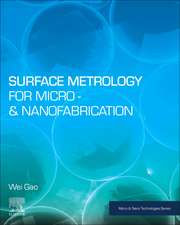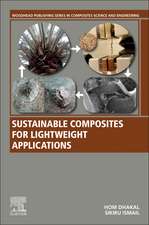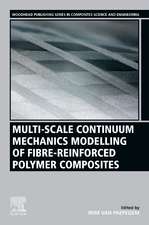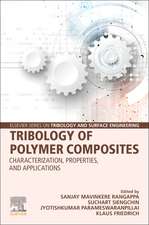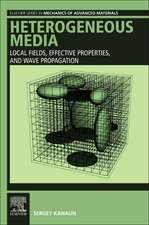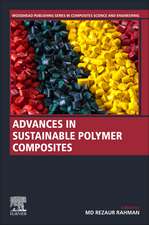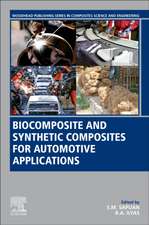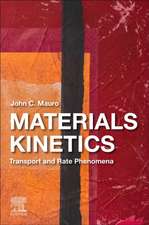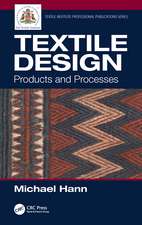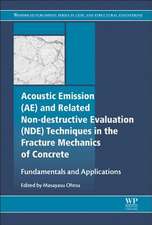Residual Stresses in Composite Materials: Woodhead Publishing Series in Composites Science and Engineering
Editat de Mahmood M. Shokriehen Limba Engleză Hardback – 12 noi 2013
- Reviews destructive and non-destructive testing (NDT) techniques for measuring residual stresses
- Discusses residual stresses in polymer matrix, metal-matrix and other types of composite
- Considers the addition of nanoparticles to the matrix of polymeric composites as a new technique for reduction of residual stresses
| Toate formatele și edițiile | Preț | Express |
|---|---|---|
| Paperback (1) | 1271.57 lei 36-50 zile | |
| ELSEVIER SCIENCE – 23 iun 2021 | 1271.57 lei 36-50 zile | |
| Hardback (1) | 999.51 lei 43-57 zile | |
| ELSEVIER SCIENCE – 12 noi 2013 | 999.51 lei 43-57 zile |
Din seria Woodhead Publishing Series in Composites Science and Engineering
- 29%
 Preț: 1151.86 lei
Preț: 1151.86 lei - 29%
 Preț: 1475.57 lei
Preț: 1475.57 lei - 24%
 Preț: 1158.68 lei
Preț: 1158.68 lei - 39%
 Preț: 1151.52 lei
Preț: 1151.52 lei - 24%
 Preț: 1448.86 lei
Preț: 1448.86 lei - 9%
 Preț: 1018.25 lei
Preț: 1018.25 lei - 29%
 Preț: 1128.18 lei
Preț: 1128.18 lei - 9%
 Preț: 1047.69 lei
Preț: 1047.69 lei - 29%
 Preț: 1066.10 lei
Preț: 1066.10 lei - 9%
 Preț: 1067.72 lei
Preț: 1067.72 lei - 29%
 Preț: 1324.17 lei
Preț: 1324.17 lei - 29%
 Preț: 1241.59 lei
Preț: 1241.59 lei - 29%
 Preț: 1211.52 lei
Preț: 1211.52 lei - 39%
 Preț: 1153.25 lei
Preț: 1153.25 lei - 9%
 Preț: 1004.94 lei
Preț: 1004.94 lei - 29%
 Preț: 1065.66 lei
Preț: 1065.66 lei - 9%
 Preț: 1138.54 lei
Preț: 1138.54 lei - 24%
 Preț: 1128.54 lei
Preț: 1128.54 lei - 9%
 Preț: 1068.32 lei
Preț: 1068.32 lei - 24%
 Preț: 1128.45 lei
Preț: 1128.45 lei - 9%
 Preț: 903.17 lei
Preț: 903.17 lei - 9%
 Preț: 1540.58 lei
Preț: 1540.58 lei - 24%
 Preț: 991.10 lei
Preț: 991.10 lei - 9%
 Preț: 1208.16 lei
Preț: 1208.16 lei - 9%
 Preț: 1325.99 lei
Preț: 1325.99 lei - 24%
 Preț: 1561.30 lei
Preț: 1561.30 lei - 24%
 Preț: 1157.48 lei
Preț: 1157.48 lei - 24%
 Preț: 1557.20 lei
Preț: 1557.20 lei - 9%
 Preț: 1210.74 lei
Preț: 1210.74 lei - 29%
 Preț: 1156.62 lei
Preț: 1156.62 lei - 29%
 Preț: 1073.93 lei
Preț: 1073.93 lei - 29%
 Preț: 1156.95 lei
Preț: 1156.95 lei - 29%
 Preț: 923.66 lei
Preț: 923.66 lei - 29%
 Preț: 1415.46 lei
Preț: 1415.46 lei - 9%
 Preț: 988.44 lei
Preț: 988.44 lei - 29%
 Preț: 1477.56 lei
Preț: 1477.56 lei - 9%
 Preț: 1333.13 lei
Preț: 1333.13 lei - 29%
 Preț: 1187.95 lei
Preț: 1187.95 lei - 9%
 Preț: 1068.17 lei
Preț: 1068.17 lei - 33%
 Preț: 944.87 lei
Preț: 944.87 lei - 24%
 Preț: 954.23 lei
Preț: 954.23 lei - 29%
 Preț: 1185.10 lei
Preț: 1185.10 lei - 29%
 Preț: 1391.50 lei
Preț: 1391.50 lei - 9%
 Preț: 1009.92 lei
Preț: 1009.92 lei - 9%
 Preț: 1069.62 lei
Preț: 1069.62 lei - 24%
 Preț: 1232.86 lei
Preț: 1232.86 lei - 9%
 Preț: 1206.61 lei
Preț: 1206.61 lei - 9%
 Preț: 1306.80 lei
Preț: 1306.80 lei - 29%
 Preț: 1309.47 lei
Preț: 1309.47 lei
Preț: 999.51 lei
Preț vechi: 1298.06 lei
-23% Nou
Puncte Express: 1499
Preț estimativ în valută:
191.29€ • 198.70$ • 158.89£
191.29€ • 198.70$ • 158.89£
Carte tipărită la comandă
Livrare economică 03-17 februarie 25
Preluare comenzi: 021 569.72.76
Specificații
ISBN-13: 9780857092700
ISBN-10: 0857092707
Pagini: 404
Dimensiuni: 156 x 234 x 24 mm
Greutate: 0.74 kg
Ediția:New.
Editura: ELSEVIER SCIENCE
Seria Woodhead Publishing Series in Composites Science and Engineering
ISBN-10: 0857092707
Pagini: 404
Dimensiuni: 156 x 234 x 24 mm
Greutate: 0.74 kg
Ediția:New.
Editura: ELSEVIER SCIENCE
Seria Woodhead Publishing Series in Composites Science and Engineering
Cuprins
- Contributor contact details
- Woodhead Publishing Series in Composites Science and Engineering
- Introduction
- Part I: Measurement and modelling
- 1. The importance of measuring residual stresses in composite materials
- Abstract
- 1.1 Introduction
- 1.2 Categories of residual stresses
- 1.3 Effects of residual stresses
- 1.4 The importance of residual stress measurement
- 1.5 Issues in the measurement of residual stresses
- 1.6 Techniques for measuring residual stress in composites
- 2. Destructive techniques in the measurement of residual stresses in composite materials: an overview
- Abstract
- 2.1 Introduction
- 2.2 The layer removal method
- 2.3 The Sachs (boring) method
- 2.4 Hole-drilling methods
- 2.5 The ring-core method
- 2.6 The cutting method
- 2.7 The contour method
- 2.8 The ply sectioning method
- 2.9 The radial cutting method
- 2.10 Matrix removal methods
- 2.11 Micro-indentation methods
- 2.12 The slitting method
- 2.13 The first ply failure method
- 2.14 The measurement of curvature method
- 2.15 Heating methods
- 2.16 Conclusions
- 3. Non-destructive testing (NDT) techniques in the measurement of residual stresses in composite materials: an overview
- Abstract
- 3.1 Introduction
- 3.2 The X-ray diffraction method
- 3.3 The neutron diffraction method
- 3.4 The Raman spectroscopy method
- 3.5 The photoelasticity method
- 3.6 Other optical methods
- 3.7 The acoustic wave method
- 3.8 Methods based on interferometry
- 3.9 The cure referencing method
- 3.10 Measurement methods using sensors
- 3.11 The electrical resistance method
- 3.12 Conclusions
- 4. Measuring residual stresses in composite materials using the simulated hole-drilling method
- Abstract
- 4.1 Introduction
- 4.2 The hole-drilling method in isotropic materials
- 4.3 The hole-drilling method in orthotropic materials
- 4.4 The hole-drilling method in laminated composites
- 4.5 Key issues in using the hole-drilling method
- 4.6 Conclusions
- 5. Measuring residual stresses in composite materials using the slitting/crack compliance method
- Abstract
- 5.1 Introduction
- 5.2 The development of the slitting method
- 5.3 Theoretical basis
- 5.4 The finite element method (FEM) for calculation of compliance functions
- 5.5 Residual shear stresses: effects on measured strains
- 5.6 Case study: residual stress measurement in a carbon/epoxy laminate
- 5.7 Conclusions and future trends
- 6. Measuring residual stresses in homogeneous and composite glass materials using photoelastic techniques
- Abstract
- 6.1 Introduction
- 6.2 Measuring residual stresses in axisymmetric glass articles
- 6.3 Measuring residual stresses in glass articles of arbitrary shape
- 6.4 Measuring residual stresses in automotive and building glass
- 6.5 Conclusions
- 6.6 Acknowledgement
- 7. Modeling residual stresses in composite materials
- Abstract
- 7.1 Introduction
- 7.2 Selecting an appropriate model
- 7.3 The elastic behavior models
- 7.4 The viscoelastic behavior models
- 7.5 Modified classical lamination theory (CLT) for modeling residual stresses
- 7.6 Future trends
- 1. The importance of measuring residual stresses in composite materials
- Part II: Residual stresses in different types of composites
- 8. Understanding residual stresses in polymer matrix composites
- Abstract
- 8.1 Introduction
- 8.2 Formation of residual stresses
- 8.3 Effects of residual stresses
- 8.4 Methods of measurement: destructive methods
- 8.5 Methods of measurement: non-destructive methods
- 8.6 Methods of prediction
- 8.7 Conclusion
- 9. Understanding residual stresses in metal matrix composites
- Abstract
- 9.1 Introduction
- 9.2 Factors affecting the magnitude and distribution of residual stresses in composites
- 9.3 The effects of residual stress on the failure of metal matrix composites (MMCs)
- 9.4 The effects of residual stress on the elevated temperature behaviour of MMCs
- 9.5 Future trends
- 10. Understanding residual stresses and fracture toughness in ceramic nanocomposites
- Abstract
- 10.1 Introduction
- 10.2 Overview of ceramic nanocomposites
- 10.3 Residual stress inside ceramic nanocomposites
- 10.4 Toughening and strengthening mechanisms in ceramic nanocomposites
- 10.5 Surface residual stress
- 10.6 Future trends
- 11. Measuring and modelling residual stresses in polymer-based dental composites
- Abstract
- 11.1 Introduction
- 11.2 Experimental and modelling approaches to study residual stresses in dental composites
- 11.3 Case study: the development of local stresses in four different dental composites
- 11.4 Further applications of the modelling approach
- 12. Understanding residual stresses in thick polymer composite laminates
- Abstract
- 12.1 Introduction
- 12.2 Modelling the curing process in thick laminated composites
- 12.3 Understanding the curing process
- 12.4 Residual stresses in thick laminated composites
- 12.5 Methods of measurement of residual stresses in laminated composites
- 12.6 Future trends
- 12.7 Acknowledgments
- 13. Reduction of residual stresses in polymer composites using nano-additives
- Abstract
- 13.1 Introduction
- 13.2 Application of nano-additives to enhance the thermal and mechanical properties of polymer composites
- 13.3 Case study: reduction of residual stresses in carbon/epoxy laminates using carbon nanofibres (CNFs)
- 13.4 Conclusions and future trends
- 8. Understanding residual stresses in polymer matrix composites
- Index


